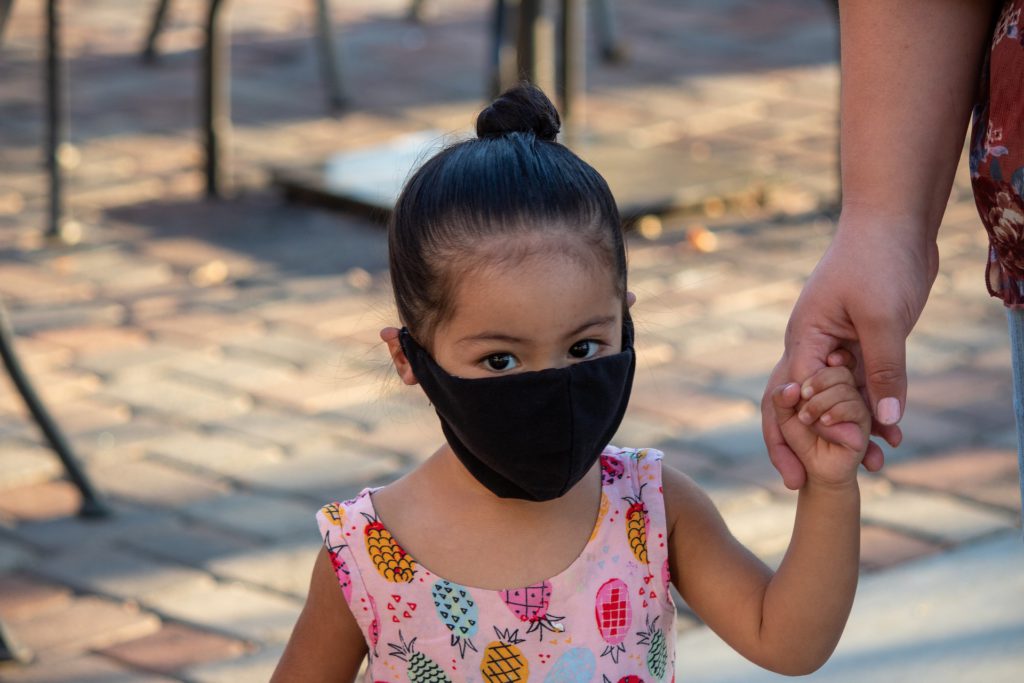Our series started out in April with reflections on the concept of a “natural disaster,” and how the impact of natural disasters is often human-made, partially created by institutional disinvestment in the infrastructures that respond to crisis. Our introductory post discussed the opportunities for solidarity between child care providers and other essential workers whose labor is often invisiblized or insultingly dismissed as unskilled. We expressed hope in a vision for the future where child care providers are recognized and fairly compensated for their absolutely essential work.
In April, we also began our COVID-19 timeline, which is regularly updated and marks developments as our state and early childhood system responds to the pandemic. This post discussed the limited emergency support provided to providers, workers and others who need them. In North Carolina, our unemployment system was severely backed up. At the time of this post, providers, advocates and researchers feared the possible loss of 4.5 million child care slots nationally, as many providers were concerned their programs would not be able to stay open. Luckily, this did not turn out to be the case, but providers are struggling with low enrollment and many advocates and providers fear a possible delayed crisis in the field this spring.
In our reflections on May and June, we discussed the ongoing Black Lives Matter and Black Trans Lives Matter protests confronting police violence and white supremacy. We discussed how Breonna Taylor’s death resonated in our field and how the long hours, low pay, lack of benefits and racial pay gap within the field reflect the ongoing impacts of the white supremacy that fuels disinvestment in the child care system. We also saw the dangerous impact of white nationalist ideas gaining traction as rioters stormed the Capitol at the beginning of January 2021, threatening the lives and safety of not just members of Congress, but all the people who work in the Capitol and D.C. residents in the surrounding area. With the early years being the most crucial time to cultivate anti-racist values, the role parents and child care providers play is crucial in confronting racial violence and supporting children who are experiencing racial trauma.
In other posts throughout the year, we discussed problems with valorizing essential workers as heroes and how putting providers on a pedestal can be dehumanizing in its own way, as child care providers did not ask to be the ones to save us. We discussed the limits of self-care, and how telling providers to care for themselves when what they really need is community care can be insulting and alienating. We reflected on what a system of community care would look like for providers, including supporting connections between providers and increasing access to peer support specialists. Of course, none of this is a substitute for addressing the racist and sexist policies that keep providers struggling and affect their mental, emotional and physical health.
In October, we reflected on voting for pandemic recovery, particularly in state and local elections, and then saw unprecedented voter turnout in November. As we move into a new year and come up on the marker of a full year spent in crisis around the world, we see some hope on the horizon with the distribution of the Moderna and Pfizer vaccines. We have seen a political shift to a democratic president, and democratic control in both chambers of Congress. It remains to be seen how this will affect COVID-19 response moving forward. Stepping into a new year, below you will find reflections of the events of September 2020 through January 2021.
View the whole timeline from the start of COVID-19 in March 2020 here.
| September 8, 2020 | The New York Times publishes an article about the state of COVID-19 testing for young children, describing how parents across the country are having difficulty finding testing sites that perform nasal swabs on young children. Pediatricians quoted in the article argue that there is no medical reason to avoid testing children, but that many sites aren’t comfortable performing the tests. CVS and Walgreens, some of the most popular testing sites, didn’t offer testing to children under age 12 at the time the article was published (in October, Walgreens began testing children age 3 and up, but the minimum age for CVS is still 12 years old). |
| September 16 | The Hechinger Report profiles family child care providers in California who won the right to collective bargaining through the Building a Better Early Care and Education System Act, passed in fall 2019. In a historic vote that took place in July 2020, more than 10,000 family child care providers across the state voted to join Child Care Providers United. Across the country, family child care providers only have the right to collective bargaining in approximately one-quarter of states. |
| September 25 | The Center for American Progress reports results from their National Survey of Registered Voters, which polled voters about child care issues ahead of the 2020 elections. About 60% of parents who responded to the study said finding child care was a “serious problem” for them, and parents with children under 6 were the most likely to have difficulty finding adequate, affordable care. Additionally, around 40% of parents said the pandemic made it more difficult for them to find care, more than half of parents were uncomfortable sending their children to center or home-based care due to pandemic health risk and many parents experienced disturbances to their ability to work or work productively. All this being said, 60% of voters surveyed wanted the government to take a more active role in the child care system, while 70% wanted increased funding for child care and early childhood education programs. The North Carolina Department of Health and Human Services renews and adjusts eligibility for the program to increase food security for children who qualify for free and reduced lunch, but may be facing difficulty accessing food during the pandemic. The program, called the Pandemic Electronic Benefit Transfer or P-EBT program, will provide families with a specific pandemic benefit on an EBT card. Children will be eligible for P-EBT if they receive free and reduced price meals and if their school district or charter school had remote learning for five days between August 17 and September 30, 2020. The program was previously available to all children who qualified for free and reduced lunch, regardless of whether their school used online learning. |
| October 2 | CCSA publishes the 2019 North Carolina Child Care Workforce Study and county-level reports, which give context to the state of the early childhood workforce right before the pandemic. With funding from DCDEE, CCSA collected data from programs in every county across the state. This report summarizes key findings from the directors, teachers, assistant teachers and family child care providers who participated. The study found that statewide, early care and education staff make an average of $12 per hour, directors average $19.23 per hour and family child care providers average just $9.09. Despite rising levels of both education and experience, wages remain low, and right before the start of a pandemic, 21% of teaching staff had no health insurance from any source. U.S. Department of Health and Human Services Secretary Alex Azar renews his declaration of a national public health emergency due to COVID-19 for a third time since his initial determination in January 2020. This allows several federal emergency COVID-19 response and relief policies to continue, including Medicaid funding increases and flexibility. |
| October 8 | The Georgetown University Health Policy Institute publishes a report about the dramatic increase in the rate of children without health insurance between 2018 and 2019. This was the largest increase in over 10 years, and will likely soon be dwarfed by 2019 to 2020 coverage losses due to pandemic-related employment and income loss. According to NC Child, an estimated 142,000 children in North Carolina had no coverage in 2019, ranking North Carolina as one of 10 states with the highest rates of uninsured children in the country. |
| October 19 | CCSA’s COVID-19 Relief Fund releases Phase II grants to child care programs impacted by the pandemic, after receiving nearly 600 applications with requests for more than $1.5 million in total. The Relief Fund supports the immediate and long-term needs of child care programs as they serve children of families returning to work, as well as essential workers on the front lines. The Relief Fund is made possible by contributions from the Blue Cross and Blue Shield of North Carolina Foundation, the PNC Foundation, Truist Charitable Fund, the ChildTrust Foundation and many private donations. |
| November 3 | Record numbers of voters turn out for the 2020 presidential election, either in person or by absentee ballot, early voting or on Election Day. Two-thirds (66.3%) of eligible voters turn out, which is the largest percentage of the electorate to vote since 1908. In addition to choosing a presidential candidate, voters decide key down-ballot races at the federal, state and local levels. |
| November 7 | After an initially close race and a slow vote-counting process because of the massive increase in absentee voting during the pandemic, it takes longer than usual to report an election result. However, on November 7, the presidential race is called and Joe Biden becomes the 46th president-elect, and Kamala Harris the 49th vice president-elect of the United States. Harris made history as the first woman of color, and first woman in general, to be elected to the office of vice president. In combination with the results of Senate and House races, the balance of power in the federal executive and legislative branches shifts to democratic control. |
| November 17 | Governor Roy Cooper launches new color-coded COVID alert system that will show which counties have the most severe COVID spread and how they compare to other counties in the state. Counties will rank red (critical community spread), orange (substantial community spread) or yellow (significant community spread) depending on rate of new cases, percent of positive tests and hospital capacity in the county. |
| November 23 | Governor Roy Cooper announces a stricter mask mandate, implemented through Executive Order 180, which goes into effect November 25. The mandate requires the wearing of a mask or face covering when in the presence of anyone not in your immediate household. The new rule establishes that masks must be worn in all indoor settings, even when 6 feet of distance or greater is possible. Large businesses must also have an employee near store entrances enforcing mask wearing. |
| December 3 | At the end of the year, approximately 90% of child care programs are open. Though this is a good sign, some experts are concerned about the possibility of a delayed outcome in the spring if relief funding runs out and cases continue to climb. Even though most programs have not permanently closed, enrollment is down significantly, sitting at about 60%. |
| December 8 | Due to a significant amount of cases, such that more than 80% of states are in the “orange” (substantial community spread) or “red” (critical community spread) categories, Governor Roy Cooper announces new stay-at-home order, including a curfew. The new curfew will be implemented December 11, 2020, and North Carolina residents must stay at home between 10 p.m. and 5 a.m. until at least January 8, 2021. |
| December 11 | NC Division of Child Development and Early Education releases the updated ChildCareStrongNC Public Health Toolkit that provides guidance in child care settings. The updated toolkit includes a new requirement related to face coverings for children ages 5 and older. All children 5 and older are now required to wear masks in school and child care settings. Exceptions apply in situations where it may be difficult or unsafe for a child to wear a face covering for medical or developmental reasons. |
| December 11-18 | The FDA issues emergency use authorization for use of the Pfizer-BioNTech COVID-19 vaccine and distribution begins within 24 hours. A few days later on December 18, the FDA also authorizes the Moderna vaccine. In clinical trials, both vaccines showed more than 94% effectiveness in preventing COVID infection. The vaccine rollout schedule will take place in several phases, with healthcare workers, residents of long-term care facilities, elderly people, essential workers and people with risk factors for increased mortality of the virus being able to receive the vaccine first. |
| December 16 | CCSA publishes the COVID-19 Relief Fund Phase II report. In Phase II of the Relief Fund, CCSA was able to provide more substantial grants to 41 child care programs across the state. The average program received $3,384 to help them purchase cleaning supplies, PPE, training, self-care programming and supplies and more. The report details the impact of these grants and includes testimonials from several child care programs that received grants from the fund. |
| December 17 | The North Carolina Early Childhood Foundation publishes the results of their survey of working parents with young children in North Carolina, conducted in October 2020. Their report describes how the pandemic has intensified pre-existing struggles for parents to access affordable child care and changed some parents’ relationships to work entirely, requiring parents to work outside normal business hours, alternate with one another or take paid or unpaid leave. The lost household income from changes in employment status due to the pandemic averages about 20%, and 30% of parents reported their financial problems were “major” or “extreme.” |
| December 27 | The Coronavirus Response and Relief Supplemental Appropriations Act is signed into law, which allocates $900 billion in COVID-19 relief funding. The act implements a second round of the Paycheck Protection Program, provides a boost to unemployment benefits and includes direct $600 payments to individuals making less than $75,000 per year. Significantly, the bill allocates $10 billion to the Child Care Development Block Grant to help families pay for child care and assist providers who are experiencing pandemic-related financial strain. North Carolina will receive an estimated $338 million of the $10 billion. CCSA breaks down the details for families and providers in blog featuring two reports. |
| December 31, 2020 | The year ends on a somber note, with a record COVID-19 death toll reported for the second day in a row (3,740 deaths). Experts predicts the total count will reach 424,000 deaths across the country by January 23, 2021. The sharp rise in cases is partially due to the impact of gatherings for the winter holidays, though the full effect of these gathering won’t be known for weeks. In North Carolina, 6,715 cases are reported, with 3,481 North Carolinians currently hospitalized. |
| January 6, 2021 | The U.S. Capitol building is stormed while Congress attempts to certify the results of the 2020 presidential election inside. The event amplifies serious concerns about the rise of white nationalism and the role of government and political figures in advancing it. The attack is the first time that the U.S. Capitol has been breached since the War of 1812, and the riot is considered a violent effort to overturn the results of the election. The attack is preceded by a Trump rally, after which attendees of the rally breach the Capitol grounds. The house floor was breached at 2:16 p.m., a minute after the evacuation of all members of Congress was complete. |
| January 14 | After slower than desirable vaccine distribution partially due to what experts call “the last mile problem,” the federal government releases new vaccine distribution guidance and many states begin adjusting their vaccine distribution plans. N.C. health officials announce the three formally announced phases for vaccine eligibility are changing to five groups. Group One is health care workers and people living in residential facilities; the second group is all adults ages 65 or older; the third is essential workers; the fourth is adults with increased risk for COVID-19 infection due to pre-existing conditions, illnesses or disabilities; and the fifth group is anyone who would like to receive a vaccine. Distribution for Group One is ongoing, but NCDHHS announced that Group Two is now eligible to receive the vaccine. |
| January 20-22 | President Joe Biden and Vice President Kamala Harris are inaugurated and given the oath of office. In his first three days in office, President Biden signs 30 executive orders, among them implementing mandatory masking on federal property, raising the federal employee minimum wage to $15 per hour, increasing vaccination supplies and re-vamping vaccine distribution efforts, requiring visitors to the US to provide proof of a negative COVID-19 test on arrival, and more. |
| January 26 | In North Carolina as of January 26, 2021, at least 723,445 people have tested positive for COVID-19, with 8,720 deaths since March 2020. With the new, more contagious strain identified in Mecklenburg County, North Carolinians are gearing up for a difficult end to the winter months and beginning of spring. State officials report a plan to open a mass vaccination site in Durham County in early February. |



